Visualisation and Demonstration of the Gambler’s Ruin
If you start with only 5 pennies, and your opponent with 10,000 pennies, then your chances are as little as 0.04975% to survive (not to go bankrupt), and furthermore you may have to play as many as 50,000 games to beat your opponent!
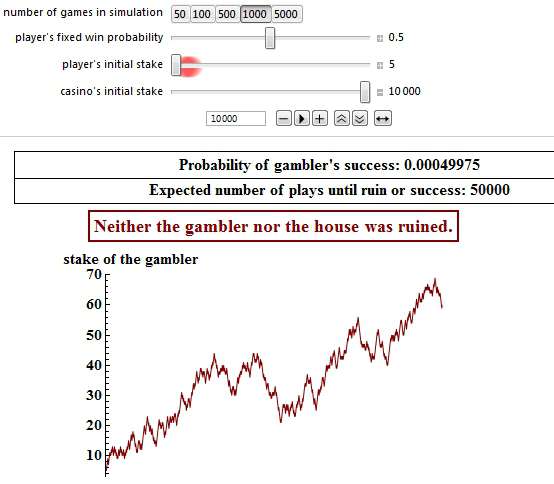
Fair Coin Tossing – players initial stake: 5 – opponents initial bank: 10,000 – simulation (1) outcome: no bankruptcy
However, in the majority of cases (99.95%) player 1 will pretty soon be bankrupt, like in this simulation:
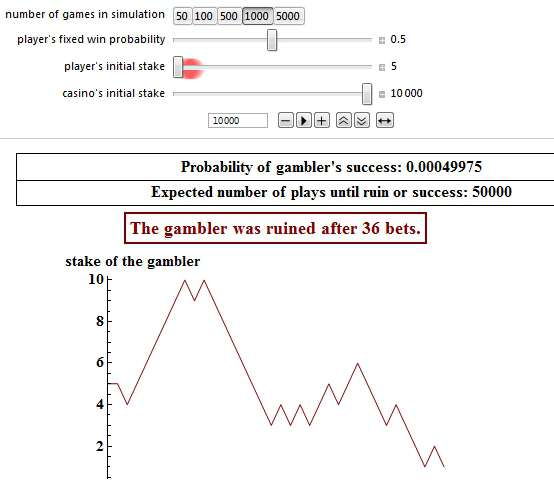
Fair Coin Tossing – players initial stake: 5 – opponents initial bank: 10,000 – simulation (2) outcome: bankruptcy after 36 coin flips
Please note that both snapshots above have had the same starting point. Player 1’s initial stake was 5 pennies and his opponent’s initial bank was 10,000. It is just that the events developed in different directions, hence a completely different outcome.
Starting with a Higher Starting Bank
If you start with a somewhat higher starting bank than just 5 pennies, say, 50 pennies, and then risk only 1% of your bank (1 penny each bet), your chances of survival increase from 0.04975% (starting with 5 pennies) to 0.497512% (of not going broke). However, this time you may have to wait 500,000 betting rounds to conquer your opponent!:
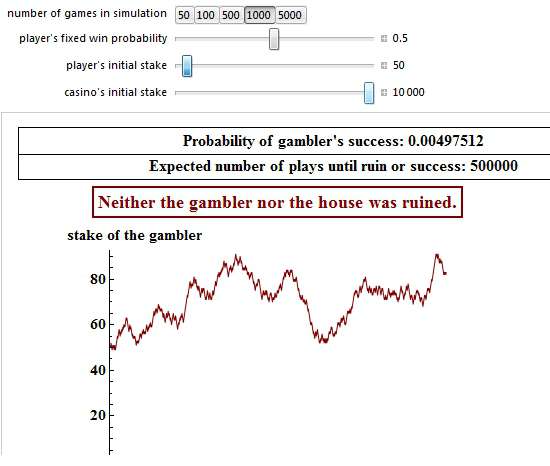
Fair Coin Tossing – players initial stake: 50 – opponents initial bank: 10,000 – simulation (3) outcome: no bankruptcy
Although the above simulation shows some success after 1,000 bets, you must not forget, that in 99.5% of all attempts, even a starting bank of 50 pennies will still lead to bankruptcy, like in the following simulation. It took a little bit longer than the 36 coin flips on the previous page, but nevertheless the gambler was ruined after 631 bets:
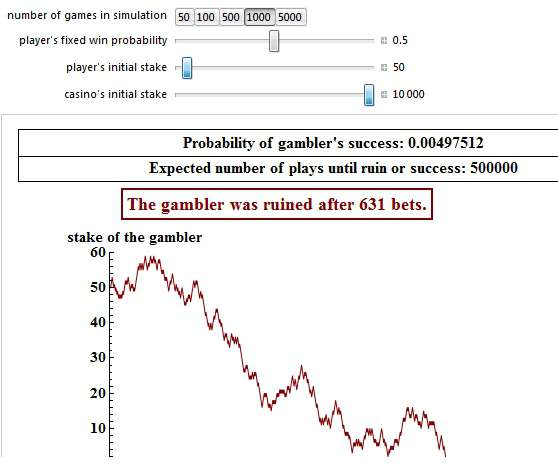
Fair Coin Tossing – players initial stake: 50 – opponents initial bank: 10,000 – simulation (3) outcome: bankruptcy after 631 betting rounds
Starting with a Larger Starting Bank
Aware of the gambler’s ruin dilemma, the gambler now increases his bank to 500 pennies and only risks 0.2% of his betting bank per bet. His chances to beat the bookie increase to 4.76%, but only if the bookie did not start with more than 10,000 pennies himself. In 95.24% of the cases, despite the higher starting bank the gambler will lose still everything and the house will win.
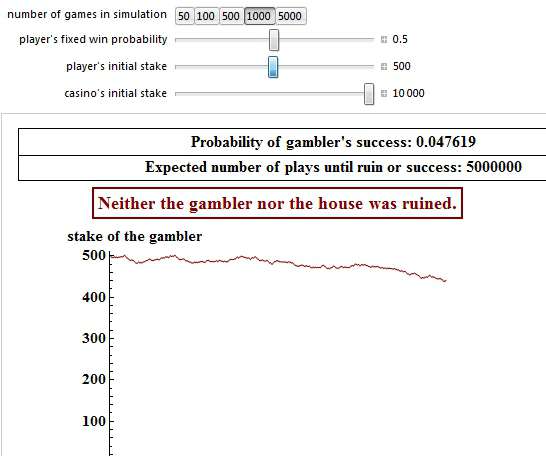
Fair Coin Tossing – players initial stake: 500 – opponents initial bank: 10,000 – simulation (4) outcome: no bankruptcy
To put a long story sideways, the gambler’s ruin dilemma essentially dictates that a gambler with finite wealth, playing a fair game will eventually go broke against an opponent with infinite wealth. The player starting out with the smallest number of pennies has the greatest chance of going bankrupt. The less pennies player 1 starts with, the greater his chances of bankruptcy.
There is no question that bookmakers have much higher funds than individual punters. This simple principle therefore provides bookmakers with a huge advantage in the long run. As bookmakers offer odds with an overround in their favour the threat of bankruptcy just looms much quicker for the gambler.
Summary
This article explained the Gambler’s Ruin conundrum when betting at zero odds. Of course, the probabilities of winning favour the gambler if he achieves a long-term mathematical advantage and bets on VALUE.
ONLY BY BETTING WITH VALUE ON YOUR SIDE CAN YOU EVER HOPE TO BEAT THE BOOKMAKER OR THE HOUSE.
Check out our odds calculation course, which teaches you how to identify “value” and how to compete with the bookmakers on level terms.
You may also find our sophisticated Excel spreadsheets useful in identifying value bets
Acknowledgements:
The snapshots on pages 3 to 5 of this article (simulations/visualizations) are taken from the WolframMathsWorld demonstrations project.
Our sincere thanks to the WolframAlpha team for providing the public with such useful mathematical information and simulations – Hopefully we have been able to interpret them in layman’s language for you!





